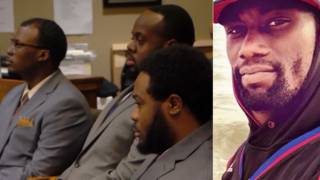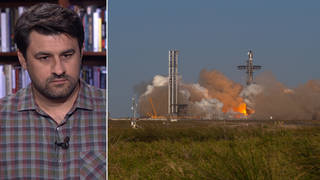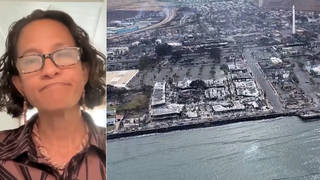
Guests
- Clay Trauernichtprofessor in the Department of Natural Resources and Environmental Management at the University of Hawaii, Manoa.
We speak to a fire scientist about how the climate emergency fueled this week’s historic wildfires on the Hawaiian island of Maui. “This is something that is absolutely unprecedented,” says Clay Trauernicht, a professor in the Department of Natural Resources and Environmental Management, University of Hawaii at Mānoa, where he focuses on wildland fire management in Hawaii and the Pacific. He explains how colonial landscape changes to the islands — prioritizing monocrop agriculture and land use for tourism — paired with the worsening atmospheric effects of climate change have set the conditions that sparked the devastating wildfires and allowed them to rage indiscriminately.
Transcript
AMY GOODMAN: This is Democracy Now!, democracynow.org. We go now from Maui to end today’s show looking at how the deadly wildfires that spread through Maui came after weeks of worsening drought conditions as the climate emergency fuels deadly fires across the globe. The U.S. Drought Monitor reports nearly 16% of Maui County is now facing a severe drought, and an additional 20% is facing moderate drought.
We’re joined in Honolulu by Clay Trauernicht, professor in the Department of Natural Resources and Environmental Management at the University of Hawaii at Mānoa, where he focuses on wildland fire management in Hawaii and the Pacific.
Welcome to Democracy Now!, Clay Trauernicht. It’s great to have you with us. Put these two issues together — you have the hurricane, hundreds of miles away, creates hurricane winds that fuel these wildfires — and how this is connected to climate change.
CLAY TRAUERNICHT: Yeah. Thanks for having me. And I’d just like to say how much I appreciate you highlighting the voices of your prior guests to kind of round out the perspective on this incident.
But in terms of these — the climate or weather events that we’ve seen, we had the combination of the storm passing to the south, this high-pressure system that really ramped up winds and lowered relative humidity over the course of a couple days. And what’s really important to understand is that those really rapid changes in weather can have huge effects on fire danger.
But the reason that they’re having the effects they are is because of the landscape-scale changes that your prior guests were mentioning. And that’s the change in the vegetation surrounding the community in Lahaina, as well as the community Upcountry Maui, which is experiencing similar fires, and which are still burning right now. And these are changes that have affected most of the island in the state, in the sense that these change in land use over the past couple decades, the decline in agricultural production, has really resulted in the dramatic expansion of these non-native tropical grasses. And this really creates this vulnerability that we’re seeing right now and, you know, the really explosive growth in fire that we saw over the past couple days.
AMY GOODMAN: Were you surprised by the scale of this disaster, and now this debate over where were the early warning — you know, so many deaths, and there are probably a number more — how it could have been dealt with in a different way? I mean, you have the governor saying this is the worst natural disaster in Hawaii’s history.
CLAY TRAUERNICHT: Yeah, I think we’re clearly grappling with the human toll. This is something that’s absolutely unprecedented. And I don’t think — I mean, just the loss and hearing these stories of your prior guests, I mean, this is going to — it’s still sinking in for all of us just how dramatic this is and just what the impact that this has had on the people, like, first of all, first and foremost.
As far as the unprecedented nature of these fires, unfortunately, this is something we’ve been seeing over the past decade, at least. And we can look back to 2019, where 21 homes were lost in West Maui due to similar fires. The same year, we had about 20,000 acres burned through central Maui. 2018, we actually had a near pass of another hurricane system that coincided with large-scale fires on Oahu, on the west side of Oahu. And in each of these incidents, what we’re seeing, I think as your first guest mentioned, is our — the firefighters we have on the ground, those are the resources we have. They were spread incredibly thin over this past week. They’re doing everything that they can.
And as far as what we can do — and by “we,” I mean the response agencies that we work with, the nonprofits, Hawaii Wildfire Management Organization — I have to give them credit, too. But we’re trying to get the word out and identify the actions that communities and land managers can take prior to these fires, and so that we can reduce risk, create safer conditions and sort of relieve the burden, which at this point really falls onto our emergency responders.
Another element or dimension to this change in land use or the limited management we see on these lands, these tropical grasslands that cover the state — there’s about a million acres — is that as those operations have kind of removed from the landscape, you lose a lot of the knowledge that was there from the workers who knew where the roads were, were maintaining the roads, maintaining water access. So, again, all of this burden falls on our firefighters, and we’re asking them to do really heavy lifting. And up until this incident, we also have to say they’ve done a commendable job of really protecting our communities. As you said, this is the worst we’ve ever seen. And all of the fires that we have seen over the past couple decades, since agriculture has been declining, our firefighters are typically very successful at protecting homes, infrastructure and human lives.
AMY GOODMAN: Professor Trauernicht, President Biden has pledged disaster relief, immediate assistance to those affected. But what would it mean if he actually outright declared not just a state emergency in Hawaii, a national climate emergency, a national state of emergency?
CLAY TRAUERNICHT: It’s a difficult question for Hawaii. We struggle here having long-term funding in place. And part of that reason, as far as the relationship with the federal government — and again, I can only really speak to the fire realm, fire management realm — is that we don’t have these large tracts of federal land. And that’s usually the mechanism through which we know national forests, Bureau of Land Management — these are the mechanisms, at least in the continental U.S., that funding kind of comes in for this kind of work.
And what we’re talking about for a disaster like this, to prevent the next one, is to support these efforts on the ground that are actually altering the condition of those fuels. And there are lots of examples, lots of people working on this, ranging from working with ranchers to do targeted grazing, doing fuel break networks to give firefighters a fighting chance, reimplementing traditional agriculture — there’s examples of folks restoring taro, lo’i wetland taro, to actually act as fire breaks — all the way through to reforestation, where we’re converting these fuels into something else, something less likely to burn.
And I think our job, what we’ve been working on, the folks doing fire prevention work for a number of years now, is just: How do we scale this up? And so, that’s really what we need to be thinking about with assistance from the federal government, is: How we can implement these actions and the knowledge that people already have? How can we do that at larger scales, coordinate across bigger spaces?
AMY GOODMAN: Well, Professor —
CLAY TRAUERNICHT: And this is something that needs to happen statewide.
AMY GOODMAN: Professor Clay Trauernicht, we thank you so much for being with us, from the University of Hawaii in Honolulu. That does it for our show. I’m Amy Goodman. Thanks so much for joining us.












Media Options